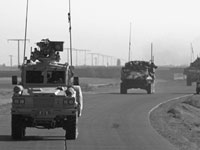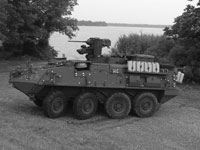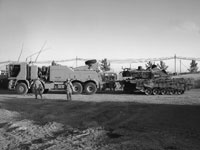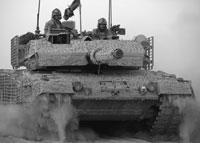Auditor General's Report: Rapid acquistion of Army vehicles for Afstan
Soldiers got tanks but paperwork wasn’t filled outMore from the Globe and Mail--the headline is misleading in their sensationalist fashion:
Forces stumbled on purchasingFrom the report:
National Defence moved quickly on several big deals for military trucks and vehicles, but at least one major purchase was poorly explained and costs skyrocketed
The Auditor-General applauded the government's ability to quickly buy dozens of military trucks and vehicles for the war in Afghanistan, but pointed out that getting there was not always pretty.
Officials at National Defence failed on a number of occasions to properly explain their actions to the rest of the government. Regarding one major purchase, the total cost quickly doubled and the vehicle has yet to be delivered...
As part of its audit, Ms. Fraser looked at the purchases of: - 75 armoured patrol vehicles, worth $175-million; - 100 Leopard 2 tanks, worth $650-million; - 95 armoured heavy-support transport vehicles, worth $169-million, and - 33 light-armoured vehicles with remote weapon stations (LAV RWS), worth $118-million.
The first three purchases were relatively well-handled, according to the Auditor-General.
However, the LAV RWS purchase was botched, with the price doubling and the delivery delayed.
“The original project schedule stated that the vehicles would be ready for use in Afghanistan by February 2008,” the report said, adding that the vehicles were not delivered as of this summer.
The project's cost has also doubled to $118-million, up from the initial estimate of $55-million...
...
Exhibit 5.2—Four types of vehicle acquisitions were audited
Armoured Patrol Vehicle (RG-31)
RG-31s in a convoy in AfghanistanDate of project approval: October 2005
Approved cost: $175 million
The purpose of this purchase was to provide the Canadian Forces with a better-protected patrol vehicle when it began operations in Kandahar region in February 2006. At the time, this purchase was the top priority of the Canadian Forces.
One of National Defence’s stated reasons for the project was to replace the G-Wagon—a small patrol vehicle that did not provide enough protection to personnel in Afghanistan. Another was to replace the Bison, a larger vehicle used to transport personnel.
In buying the RG-31, the Department got a vehicle that includes a remote weapon station (RWS). This allows an operator to fire weapons from within the vehicle—using a monitor and joystick—while remaining protected.
The Department bought 75 RG-31s under contract with General Dynamics Land Systems Canada (GDLS-Canada). They have been used in Afghanistan and for training in Canada.
Light Armoured Vehicle Remote Weapon Station (LAV RWS)
LAV RWSDates of project approval: October 2006, March 2007, and April 2007
Approved cost: $118 million
The purpose of this purchase was to produce a variation of the Canadian Forces’ Light Armoured Vehicle III (LAV III) that would provide better protection against mines and IEDs. The LAV RWS would be used in the same manner as the existing LAV Infantry Section Carrier.
Two key features of the new vehicle are a remote weapon station (RWS) and custom armour protection. Instead of the turret mounted on the standard LAV, the RWS reduces the vehicle’s weight by several thousand pounds, which allows additional armour to be installed. Never-used chassis from the original LAVs are being used as the basis for producing 33 of the LAV with RWS.
Under contracts with General Dynamics Land Systems Canada (GDLS-Canada) and Armatec, the vehicles are currently being produced for delivery in 2009.
Armoured Heavy Support Vehicle System (AHSVS)
AHSVS transporting a damaged tankDate of project approval: October 2006
Approved cost: $169 million
The purpose of this purchase was to replace the Heavy Logistic Wheeled Vehicle that was being used in Afghanistan with a vehicle better protected against the threat of improvised explosive devices (IEDs). It is mainly used to transport supplies and equipment.
Ninety-five vehicles of various types, and related equipment, have been acquired under contract with DaimlerChrysler AG. These are currently used for operations in Afghanistan and for training in Canada. Two additional vehicles are still to be received as compensation for delivery delays.
Leopard 2 Tank
Leopard 2 TankDate of project approval: March 2007
Approved cost: $650 million
The first goal was to lease 20 Leopard 2 tanks and two special-purpose armoured vehicles from Germany in order to meet the urgent need to replace the Leopard 1 tanks that had been deployed to Afghanistan.
The second goal was to purchase 100 Leopard 2 tanks, including special- purpose armoured vehicles from the Netherlands, to provide immediate training vehicles for troops in Canada and a longer-term tank capability.
Twenty tanks were borrowed (not leased as originally approved by the government) from Germany. These arrived in Afghanistan, for the most part, in late 2007.
One hundred tanks were purchased. Under a separate authority, National Defence purchased an additional 15 used tanks that it intends to use for spare parts. The project is still in progress.
Source: Department of National Defence...
...there are so many procurement programs going on that they too are moving a little too fast to handle. “We’ve got more equipment programs ongoing right now than we can actually manage at one time,” he explains, “and as a result we are prioritizing and sliding some to the right...















0 Comments:
Post a Comment
<< Home